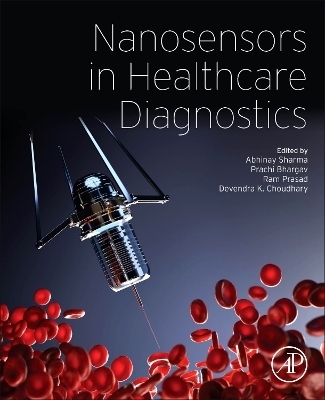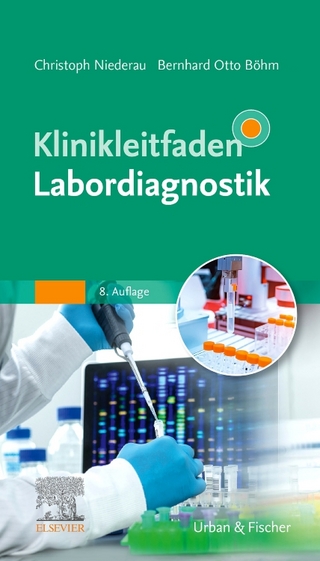
Nanosensors in Healthcare Diagnostics
Academic Press Inc (Verlag)
978-0-443-19129-9 (ISBN)
- Noch nicht erschienen (ca. Dezember 2024)
- Versandkostenfrei innerhalb Deutschlands
- Auch auf Rechnung
- Verfügbarkeit in der Filiale vor Ort prüfen
- Artikel merken
This book addresses the concept of nanosensors and their utilization in healthcare diagnostics, and therapy. It covers the principles and mechanisms involved in nanosensor-based diagnostics platforms. It also discusses various approaches and techniques used in the preparation of nanosensors as well as the biomedical application of nanosensors in clinical diagnostics and their significance in the detection, treatment, and management of diseases. This book is a useful reference for researchers, graduate students, and industry professionals studying nanosensors in biological and medical sciences.
Dr. Abhinay Sharma is currently a PBC postdoctoral fellow in Department of Microbiology and Molecular Genetics at The Institute for Medical Research – Israel-Canada (IMRIC), Faculty of Medicine, The Hebrew University, Jerusalem, Israel. Dr. Sharma also worked as CNPq postdoctoral fellow from 2011 to 2012 in the Department of Physiology at the Bioscience Institute, University of Sao Paulo, Brazil, a Postdoctoral fellow from 2012 to 2013 in Department of Medical Microbiology at the Helmholtz Centre for Infection Research, and was an Alexander von Humboldt postdoctoral fellow from 2013 to 2016 in the Department of Vaccinology at the Helmholtz Centre for Infection Research, Braunschweig, Germany. Dr. Prachi Bhargava has over 20 years of teaching and research experience in microbial molecular biology and is currently working as an Associate Professor at Shri Ramswaroop Memorial University, Lucknow. She has worked as a Principal Investigator on various major GOI-sponsored projects and was recently involved in a project sponsored by SERB, New Delhi. As an active researcher, Dr. Bhargava has published numerous research and review articles in respected journals and authored several book chapters. Dr. Ram Prasad is an Associate Professor at Mahatma Gandhi Central University, Bihar, India. Dr. Prasad has served as an Assistant Professor Amity University Uttar Pradesh, India; Visiting Assistant Professor, Whiting School of Engineering, Department of Mechanical Engineering at Johns Hopkins University, Baltimore, United States, and Research Associate Professor at School of Environmental Science and Engineering, Sun Yat-sen University, Guangzhou, China. Dr. Prasad has more than two hundred publications to his credit, including research papers, review articles, and book chapters; has edited or authored several books; and has five patents issued or pending. He’s on the editorial boards of a number of journals, and his research interests include plant-microbe interaction, agriculture sustainability, nanobiotechnology, and applied microbiology. Dr. Devendra Kumar Choudhary is a member of the National Academy of Sciences (MNASc), India. He was included in the Top 2% world scientists list published in PLoS Biology (A Stanford University Study). He holds a PhD in Microbiology and is currently working as an Associate Professor at Amity University, Noida. He has published over 90 articles in renowned national and international journals.
List of contributors
About the editors
Foreword
Preface
CHAPTER 1 Nanobiosensors for point-of-care diagnostic applications
Namrata Sangwan, Radhika Dhawan, Arushi Chauhan, Jitender Singh and Pramod K. Avti
1.1 Introduction
1.2 Diagnostic biological markers
1.2.1 Protein biological markers
1.2.2 Metabolites biological markers
1.2.3 Nucleic acid biological markers
1.2.4 Pathogenic biological markers
1.3 Diagnostic role of nanobiosensors in biomedical field
1.3.1 Noncommunicable diseases
1.3.2 Communicable diseases
1.4 Summary and future perspective
References
CHAPTER 2 Gold-conjugated polymeric nanoparticles as biosensors
Sarin Palakkal
2.1 Introduction
2.1.1 Gold nanoparticle-based piezoelectric biosensors
2.2 Biosensor’s state of the art
2.2.1 Gold nanoparticles sensing by fluorescence quenching
2.2.2 Gold nanoparticles surface plasmon resonance-based sensors
2.2.3 Detection of metal ions
2.3 Detection of small organic molecules and protein
2.4 Conclusions
References
CHAPTER 3 Biosensors for detection of Alzheimer’s disease: a review
Manju Tewari
3.1 Introduction
3.1.1 Neurodegenerative diseases
3.1.2 Alzheimer’s disease and its diagnosis
3.2 Biomarkers of Alzheimer’s disease
3.2.1 Amyloid beta proteins
3.2.2 Tau protein
3.2.3 Apolipoprotein E4
3.3 Biosensors
3.3.1 Bioreceptors
3.3.2 Transducers
3.3.3 Signal amplification
3.4 Conclusion
Acknowledgments
Conflict of interest
References
CHAPTER 4 Nanodrug delivery—a noble approach in neurodegenerative disorder and glioblastoma
Kumudesh Mishra and Or Kakhlon
4.1 Introduction
4.2 Neurological diseases and treatment strategies
4.2.1 Neurodegenerative disease
4.3 The bloodbrain barrier and nanotechnology
4.4 Bloodbrain barrier crossing mechanism by nanomaterial
4.5 Nanocarriers in drug delivery
4.5.1 Inorganic nanocarriers for drug delivery
4.5.2 Organic nanocarriers
4.6 Recent advancements in nano-based treatment of brain disorders
4.6.1 Scaffold
4.6.2 Three- and four-dimensional printing
4.6.3 Induced pluripotent stem cells
4.6.4 Nanocarrier-based gene therapy
4.7 Clinical trials and current status of nanomedicines in the treatment of neurodegenerative diseases
4.8 Challenges and approaches to overcome barriers in the nano-based treatment of neurodegenerative diseases and glioblastoma multiforme
4.9 Conclusion and future perspective
References
CHAPTER 5 Advancements in nanosensors for an early detection of cancer
Ashmit Verma, Payal Kumar, Muzammil Kuddushi, Gayatri Joshi, Saumyakanti Khatua, Mukesh Dhanka and Deepak S. Chauhan
5.1 Introduction
5.2 Classification of nanosensors
5.2.1 Based on the materials used
5.2.2 Based on the mode of transduction
5.3 Role of nanosensors in an early detection of cancer
5.3.1 Detection of biomarkers
5.3.2 Detection of circulating tumor cells and exosomes
5.3.3 Probing of living cancer cells
5.3.4 Bioimaging of tumors
5.3.5 Artificial intelligence with nanosensors for bioimaging
5.3.6 Micro- and nanorobotics for an early detection of cancer
5.3.7 Conclusion
Acknowledgments
References
CHAPTER 6 Biomedical applications of nanobiosensors in cancer—recent advances and future prospects
Rajalakshmi Manikkam, Periyasamy Vijayalakshmi, Sabapathy Indu and Balakrishnan Solaimuthu
6.1 Introduction
6.1.1 Cancer onset and types
6.2 Cancer diagnostic tools
6.3 Nanotechnology
6.3.1 Classification of nanoparticles
6.3.2 Nanoparticles in biomedical applications
6.4 Nanomaterials as biosensors—a novel approach to cancer diagnostics
6.5 Cancer biomarkers
6.5.1 Detection method
6.6 Nanobiosensors
6.7 Clinical trial of biosensors
6.8 Advantages of nanobiosensors
6.9 Conclusion
References
CHAPTER 7 Nanomaterial-based nanosensors for food safety applications
Arushi Chauhan, Namrata Sangwan, Radhika Dhawan, Jitender Singh and Pramod K. Avti
7.1 Introduction
7.2 Food safety and nanosensors
7.3 Types of nanosensors
7.3.1 Optical sensors
7.3.2 Piezoelectric sensors
7.4 Application in healthcare trends
7.4.1 Food processing
7.4.2 Nutraceuticals delivery and food packaging
7.4.3 Food safety
7.5 Conclusion
References
CHAPTER 8 Nanosensors in medical microbiology
Muhammad Hashim Khan, Sohail Ahmad, Irum Batool Hashmi and Muhammad Badar
8.1 Introduction
8.1.1 Foodborne and clinical pathogens
8.2 Sensing of pathogens from food and clinical samples by using nanosensors
8.3 Types of nanobiosensors
8.3.1 Optical nanobiosensors
8.3.2 Colorimetric nanobiosensors
8.3.3 Electrochemical nanobiosensors
8.3.4 Thermometric nanobiosensors
8.3.5 Piezoelectric nanobiosensors
8.3.6 Microfluidic nanobiosensors
References
CHAPTER 9 Nanosensors technology for diagnosis of viral infections
Anupam Singh and Ashish Kumar Rai
9.1 Introduction
9.2 Nanosensors: a brief overview
9.2.1 Definition and functionality
9.2.2 Types of nanosensors
9.2.3 Nanosensors for viral detection
9.2.4 Nanosensors for specific viral infections
9.2.5 Challenges and limitations
9.2.6 Future perspectives
9.3 Conclusion
References
CHAPTER 10 Nanosensor-based therapeutic interventions to diagnose and cure bacterial infections
Shreya Mahato, Aparna Anand and Abhinay Sharma
10.1 Introduction
10.2 Conventional diagnostic and therapeutic methods of bacterial infections
10.3 Application of nanotechnology for bacterial infection management
10.4 Nanodiagnostics for bacterial infection
10.4.1 Magnetic nanoparticles
10.4.2 Metal nanoparticles
10.4.3 Nanowire-based biosensors
10.4.4 Quantum dots
10.4.5 Surface-enhanced photoluminescence
10.4.6 Surface-enhanced Raman scattering
10.4.7 Field-effect transistors
10.4.8 Fluorescent nanosensors
10.4.9 DNA microarray
10.5 Nanotherapeutics
10.5.1 Inorganic nanoparticles
10.5.2 Organic nanoparticles
10.5.3 Quantum dots
10.5.4 Nanowires
10.5.5 Nanocarriers
10.5.6 Others
10.6 Conclusion
References
CHAPTER 11 Use of nanotechnology in diagnosis and cure of mycotic infections
Shreya Mahato, Nupur Saxena, Aparna Anand and Abhinay Sharma
11.1 Introduction
11.2 Nanotechnology for diagnosis and cure of mycotic infections
11.3 Nanodiagnostic techniques
11.3.1 Gold nanoparticles
11.3.2 Magnetic nanoparticles
11.3.3 Quantum dots
11.3.4 Nanorods and nanotubes
11.3.5 Nanowires
11.3.6 Nanoprobes or nanosensors
11.3.7 Nanobarcodes
11.3.8 Surface-enhanced Raman scattering nanotags
11.3.9 Surface plasmon resonancebased detection
11.3.10 DNA microarray
11.3.11 Other techniques
11.4 Therapeutics of mycotic infections
11.4.1 Conventional therapeutic methods for fungal infections
11.4.2 Intervention of nanotechnology mycotic therapeutics
11.5 Conclusion
References
CHAPTER 12 Potential applications of nanotechnology in management of parasitic diseases
Aparna Anand and Abhinay Sharma
12.1 Introduction
12.2 Traditional diagnosis and treatment methods of parasitic diseases
12.3 Nanotechnology aided diagnosis and treatment of parasitic diseases
12.3.1 Liposomes
12.3.2 Solid lipid nanoparticles
12.3.3 Quantum dots
12.3.4 Polymeric nanoparticles
12.3.5 Metal nanoparticles
12.3.6 Nanosensors
12.3.7 Carbon nanotubes
12.3.8 Dendrimers
12.3.9 Nanoemulsions
12.3.10 Nanotechnology-based vaccines
12.4 Conclusion
References
CHAPTER 13 Green-synthesized nanoparticles for biomedical sensor technology
Ayse Baran, Mehmet Firat Baran, Polat Ipek, Aziz Eftekhari, Cumali Keskin, Mehmet Nuri Atalar and Mehmet Hakki Alma
13.1 Introduction
13.2 Obtaining of nanoparticles
13.2.1 Nanoparticle synthesis with plants or green synthesis
13.3 Biosensors
13.3.1 Classification of sensors
13.3.2 Introduction to nanobiosensors (nanomaterial-based biosensors)
13.3.3 Applications of nanobiosensors
13.4 Conclusion
References
Index
| Erscheint lt. Verlag | 30.12.2024 |
|---|---|
| Verlagsort | San Diego |
| Sprache | englisch |
| Maße | 191 x 235 mm |
| Gewicht | 450 g |
| Themenwelt | Studium ► 2. Studienabschnitt (Klinik) ► Anamnese / Körperliche Untersuchung |
| Technik ► Umwelttechnik / Biotechnologie | |
| ISBN-10 | 0-443-19129-8 / 0443191298 |
| ISBN-13 | 978-0-443-19129-9 / 9780443191299 |
| Zustand | Neuware |
| Haben Sie eine Frage zum Produkt? |
aus dem Bereich


